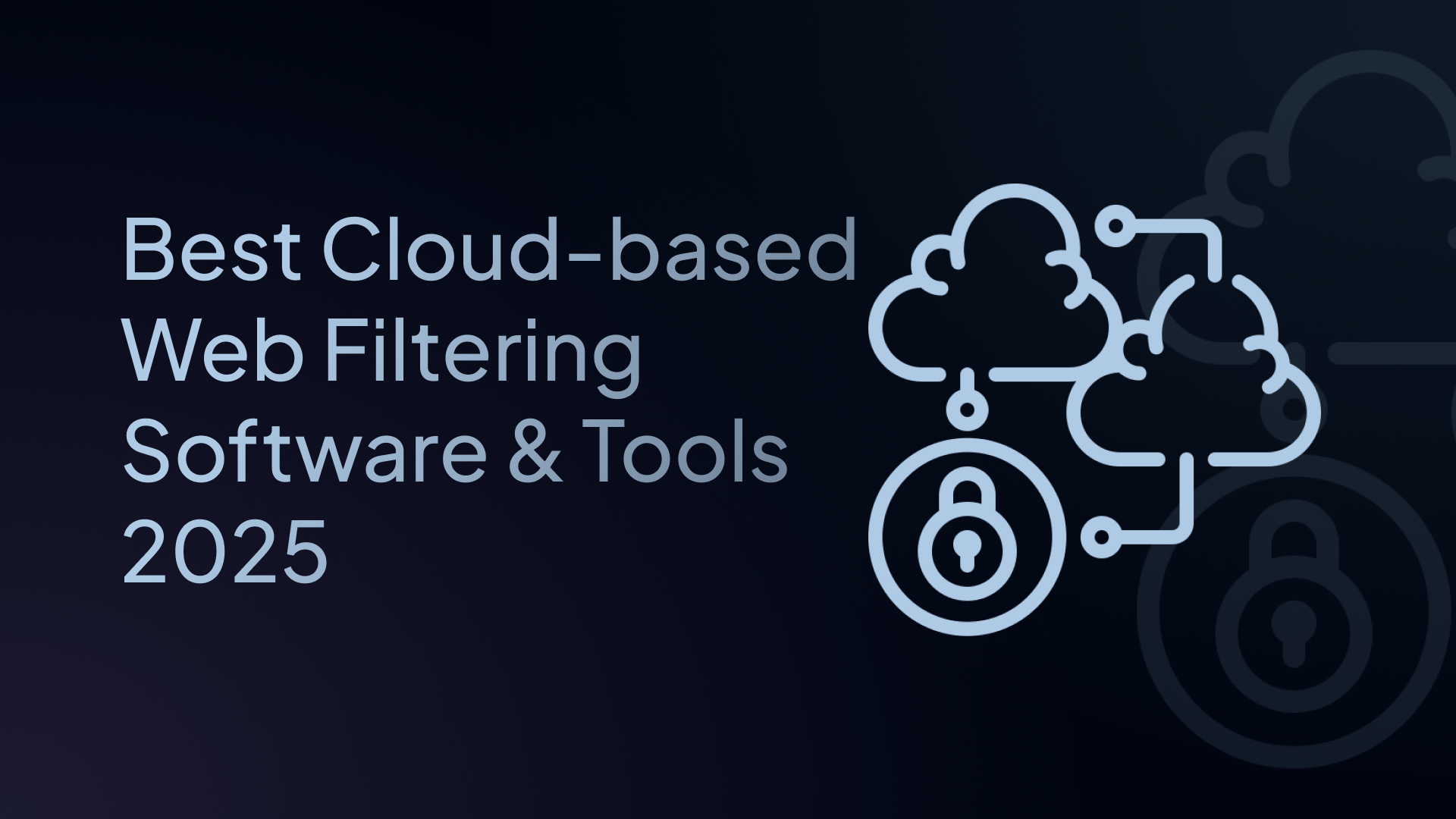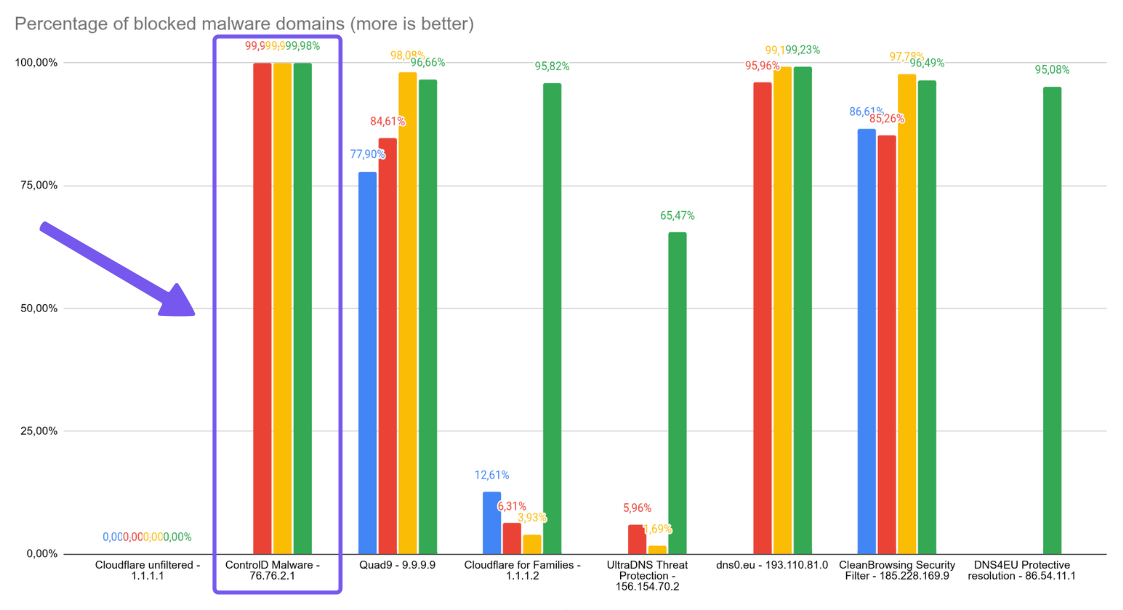9 Best Cloud-Based Web Filtering Software & Tools 2025
Find the 9 best cloud-based web filtering software for 2025. Filter harmful content, stop threats, and keep your users safe and productive.

The internet doesn’t come with a filter, and that’s a problem for businesses, schools, and IT teams trying to keep users safe and productive.
From malware-laced websites and phishing scams to time-wasting content and compliance risks, unfiltered web access can quickly become a liability.
Unfortunately, traditional on-premise solutions simply can't keep up; that’s where cloud-based web filtering comes in.
It offers flexible, scalable protection that works across locations, devices, and user types so your business and employees are constantly protected at all times.
In this guide, we break down the 9 best cloud web filtering services for 2025 so you can decide which platform is best for your specific needs.
🏆 Summary: Best Cloud Web Filtering Tools in 2025
| Rank | Tool | Web Filtering | Threat Blocking | Ease of Use |
|---|---|---|---|---|
| 1. | Control D | ✅✅✅ | ✅✅✅ | ✅✅✅ |
| 2. | Cloudflare | ✅✅ | ✅✅ | ❌❌ |
| 3. | SafeDNS | ✅✅ | ✅✅ | ✅✅✅ |
| 4. | DNSFilter | ✅✅ | ✅✅ | ✅✅ |
| 5. | Zorus | ✅✅ | ✅✅ | ✅✅ |
| 6. | DefensX | ✅✅ | ✅✅ | ✅✅ |
| 7. | WebTitan | ✅✅ | ✅✅ | ✅ |
| 8. | Cisco Umbrella | ✅ | ✅✅ | ❌❌ |
| 9. | ScoutDNS | ✅ | ✅ | ✅✅✅ |
1. Control D – The Best Overall Solution
Control D is a modern cloud web filtering solution that combines enterprise-grade security with a user-friendly interface. It offers advanced threat protection, unmatched control and customization of filtering policies, and fast performance through its global network of servers, all at an affordable price point.
Here’s why it’s trusted by industry experts.
Best-in-Class Malware Protection
Control D leads the industry in malware blocking with an independently verified malware block rate of 99.98%, stopping threats before they reach your network and devices.

Instead of relying solely on precompiled blocklists, Control D combines proprietary threat intelligence feeds and AI-powered machine learning to identify and block malicious web pages as they emerge in real time, so you and your business are always protected.
Granular Filtering & Customization
Control D provides 20 content categories you can block access to, ranging from adult content and gaming to IoT telemetry and newly registered domains. This allows you to quickly shape broad filtering policies.
However, the real customization comes at the Service level with filtering options for more than 1,000 apps, platforms, and tools, allowing you to fine-tune filtering policies to specific needs.
This flexible, modular approach makes it easy to build policies around different departments, user groups, or clients without any compromises.
Third-Party Blocklists
Control D supports integration with over 15 well-known third-party blocklists, including respected names such as Hagezi, StevenBlack, and OISD, allowing you to layer in proven protections without starting from scratch.
You can use these blocklists on their own or combine them with your existing DNS rules. Need something more specific? You can also upload your own custom blocklists as Filters (upon request) to match the unique needs of your organization.
Advanced Geo-Custom Rules
With its Geo-Custom Rules feature, Control D gives you fine-tuned control over where your DNS traffic goes based on real-world geography and network attributes. You can create rules that account for country-level restrictions, IP origins, and ASN-specific traffic handling.
Examples of what you can configure:
- Block DNS queries resolving to IPs in a specific country or ASN
- Redirect queries that don't resolve to IPs in a specific country or ASN
- Bypass queries made from IPs in a specific country or ASN
- Block queries made from IPs not in a specific country or ASN
- Or any combination of the above
This feature is especially valuable for companies managing sensitive data, meeting compliance standards, or trying to avoid exposure to hostile or high-risk regions.
Traffic Redirection
Additionally, Control D lets you route DNS queries through specific regions without a VPN thanks to its Traffic Redirection feature.
You can apply a global default location for all DNS requests or set highly specific rules to redirect traffic for individual services or domains. For example, route Spotify through Japan, but Zoom through the U.S.
With access to 100+ proxy locations in over 60 countries, you can redirect DNS traffic to your location of choice to meet data compliance needs, improve speed, and enhance privacy.
Multi-Tenancy
Control D makes managing multiple environments simple, scalable, and secure. Its built-in multi-tenancy capabilities let you create separate spaces – known as Sub-Organizations – each with its own filtering rules, DNS settings, and user access.
From a single interface, you can manage dozens (or hundreds) of separate environments without overlap or confusion. Each tenant operates independently, allowing for tailored filtering and security policies while maintaining centralized visibility and control.
Ad & Tracker Blocking
Blocking ad servers and tracking domains directly at the DNS level prevents annoying banners, autoplay videos, and hidden trackers from ever loading in the first place.
Websites load quicker, user data stays private, and your network isn’t bogged down by third-party junk. And because it works across your entire network, not just inside a browser, it protects every device, regardless of platform or operating system.
Choose from three levels of ad and tracker blocking – Relaxed, Balanced, or Strict – to match your organization’s needs.
Dual-Stack Ready & Modern Protocol Support
Control D supports both IPv4 and IPv6 natively to ensure seamless performance across dual-stack environments.
On the protocol side, Control D offers full compatibility with the latest in encrypted DNS technologies. That includes DNS-over-HTTPS (DoH), DNS-over-TLS (DoT), DoH/3, and DNS-over-QUIC (DoQ) to secure your DNS traffic from end to end, protecting it from interception, manipulation, or surveillance.
Comprehensive Analytics & Monitoring
Control D gives you deep visibility into what’s happening across your network with both real-time monitoring and historical reporting. You can track which domains were blocked, which Filters were triggered, and how each endpoint is behaving over time.
If you need to feed this data into your existing systems, you can export logs or stream them directly to your SIEM tool. If you don’t want to get bogged down in the details, simply set up automated reports on a daily, weekly, or monthly basis.
Cross-Platform Compatibility
Control D is designed to work wherever your users are, which means it can be used on any device and in any environment. It supports all major operating systems, including Windows, macOS, Linux, iOS, and Android, as well as browser-only setups and most modern routers.
Full API Access
Control D’s API lets you manage everything from provisioning endpoints and customizing Filters to automating policy changes and syncing with external systems, all without needing to access the dashboard. It’s open and fully featured from day one.
Transparent & Affordable Pricing
Pricing is simple and honest. Every customer, regardless of size or industry, gets full access to all features from the start. That means no locked features, no paywalled tools, and no surprise upgrades down the line:
- Enterprises – $2 per endpoint, per month
- MSPs – $1 per endpoint, per month
- Schools & Non-Profits – Special discounted rates available on request
Summary
✅ Pros
- Powerful web filtering with detailed customization options
- Strong protection against malware, phishing, and other threats
- Real-time analytics with clear, easy-to-use reporting dashboards
- Fast DNS performance powered by a global network
- Responsive, helpful customer support
- Extra features like geo-blocking and traffic redirection
- Works without needing to install any apps or software
❌ Cons
- No free plan besides a 30-day free trial
- No URL filtering
Why it's the best: Control D gives you enterprise-grade security and web content filtering customization, without slowing you down or adding enterprise bloat and cost.
2. Cloudflare Gateway
Cloudflare Gateway is all about speed and scale. It uses Cloudflare’s massive global network to block malicious content and handle secure web traffic. However, to truly maximize its benefits, it’s best to fully integrate with the Cloudflare ecosystem, which may not be ideal for everyone.
Additionally, many online users have reported that Cloudflare’s support is inconsistent. Some people report not getting replies at all, which can be frustrating if something goes wrong.
✅ Pros
- Leverages Cloudflare's massive global server network for fast DNS resolution
- Built-in threat detection
- Integrates with Cloudflare Zero Trust and other Cloudflare product offerings
❌ Cons
- Advanced settings can be confusing
- Setup and configuration may require technical knowledge
- Key advanced features are only available on higher-tier plans
- Among the most costly options available
- Limited flexibility when customizing filtering policies
3. SafeDNS
SafeDNS keeps things simple. It’s not trying to be a full-blown security platform, just a solid way to block harmful or malicious domains. That makes it a good fit for schools and smaller teams that don’t have a big IT staff. It’s easy to set up, does the basics well, and doesn’t overcomplicate things.
That said, it doesn’t have some of the advanced threat protection that other tools offer, and its filtering options aren’t as flexible if you need more fine-tuned control.
✅ Pros
- Budget-friendly pricing
- Easy for non-tech users
- Covers essential content categories with baseline filtering options
❌ Cons
- Fewer advanced features
- Reporting and analytics are fairly minimal compared to competitors
- Not ideal for enterprise networks
4. DNSFilter
DNSFilter takes a newer, smarter approach to content filtering. Instead of relying on old-school blocklists, it uses real-time AI to spot threats as they happen. It’s quick to set up and flexible enough for both growing businesses and MSPs, without the usual complexity you get with bigger enterprise tools.
However, it doesn’t support DNS-over-HTTPS (DoH), and you won’t find detailed controls for blocking specific apps or Services. It’s also missing a few advanced features that other platforms include, which can be a limiting factor.
✅ Pros
- AI-powered threat detection
- Clean, intuitive user interface
- Decent threat categorization
❌ Cons
- Features like SIEM integration and data exports require extra fees
- Lacks advanced reporting or actionable insights
- Minimal options for deep policy customization
5. Zorus
📌 Note: DNSFilter acquired Zorus in April 2025.
Zorus is designed for MSPs, providing solid filtering and monitoring tools, plus easy ways to brand and resell the service. It’s worth keeping in mind that Zorus doesn’t work on Linux or mobile devices, and the macOS agent is still in beta. It also doesn’t offer many options for customizing what gets filtered, which may be a downside for some teams.
✅ Pros
- Built for remote teams and MSPs
- Includes user behavior analytics
❌ Cons
- Lacks support for Linux systems and mobile platforms
- Fewer advanced features compared to other solutions
- Scalability may be insufficient for rapidly growing organizations
6. DefensX
DefensX focuses on keeping users safe right in the browser. It’s a lightweight, cloud-based tool that combines DNS filtering, browser isolation, and some email protection. However, it’s primarily designed with MSPs in mind and doesn’t offer many in-depth filtering options.
✅ Pros
- DNS filtering, secure browsing, and email protection
- Simple deployment process
- Focused on remote user safety
❌ Cons
- Offers less flexibility and customization compared to other solutions
- Basic threat protection
- Missing several advanced features found in competing tools
7. WebTitan
Built by TitanHQ, WebTitan is fairly reliable and backed by solid support. If you want simple, effective web filtering, WebTitan can be a good fit. That said, it’s missing a few advanced features. You can’t block specific Services or set up location-based rules, and it doesn’t support DNS-over-TLS (DoT). It also doesn’t work well with mobile devices.
✅ Pros
- Reporting and policy management
- Solid coverage of core content filtering categories
- Designed with MSPs in mind, offering multi-client support
❌ Cons
- User interface feels outdated and clunky
- Does not support Linux systems or mobile platforms
- Some users report unreliable or inconsistent performance
- Limited customization options for filtering policies
8. Cisco Umbrella
Cisco Umbrella is more than just DNS filtering. It also packages a secure web gateway, firewall tools, and CASB features all in one platform. It’s built for larger organizations that are already using Cisco products and have the IT team to handle a more complex setup.
However, it can be a lot for smaller businesses to manage, both in terms of cost and complexity. Additionally, many users have reported that support after purchase isn’t great, which can be frustrating if you encounter issues.
✅ Pros
- Includes security features beyond web filtering
- Ideal for large corporate networks
- Seamless integration with Cisco’s hardware and software ecosystem
❌ Cons
- High cost may be prohibitive for small and mid-sized businesses
- Complex interface and setup, especially if you only need basic web filtering
- Works best within Cisco’s product ecosystem
- Customer support can be hit or miss
9. ScoutDNS
ScoutDNS is built to make DNS filtering quick and easy, especially for schools and smaller IT teams. The dashboard is easy to use, managing multiple networks is straightforward, and it skips the extra complexity that you don’t really need. It’s a lightweight option that focuses on doing the basics of web filtering well.
It’s worth noting that it’s not great for more advanced setups. It doesn’t work with Linux or mobile devices, and features like SIEM log streaming and Active Directory support are only available on higher-priced plans. So if you need those, expect your monthly cost to go up.
✅ Pros
- Easy to set up and use
- Budget-friendly pricing
- Covers essential web filtering categories
❌ Cons
- Reporting and analytics are fairly basic
- Lacks advanced features and integrations
- Not much flexibility in customizing filtering rules
- Not ideal for large or complex network environments
How to Choose the Best Cloud-Based Web Filtering Tool
Choosing the right cloud-based web filtering tool comes down to finding the right mix of protection, control, and ease of use. Here are the key things to look for:
- Strong Category Filtering – Ensure the tool can block a wide range of content types, including adult sites, gambling, social media, and more, with options to create custom rules tailored to your unique needs.
- Real-Time Threat Protection – Look for solutions that actively block malware, phishing attempts, and other threats as they occur, rather than relying solely on outdated blocklists.
- Speed and Performance – Web filtering shouldn’t slow you down. Fast DNS resolution times are crucial for maintaining smooth and reliable internet speeds.
- Clear Reporting and Analytics – Helps you see what’s being blocked, who’s accessing what, and where potential risks are coming from.
- User-Based Policies – The ability to apply different rules to different users, groups, or departments is essential, especially in larger or more complex organizations.
- User-Friendly Management – Whether you’re a solo admin or part of a larger IT team, the dashboard should be simple to navigate, with easy policy controls.
- Scalability – As your organization grows, your filtering solution should scale with you without forcing a full rebuild or migration.
- Responsive Support – When something breaks or a threat hits, fast and helpful customer support is a must.
- Cost vs. Value – Don’t just go for the cheapest option. Choose a platform that aligns with your budget and delivers the features you actually need.
What Is Cloud-Based Web Filtering?
Cloud-based web filtering blocks or restricts access to specific domains, apps, or entire content categories using a remote server. It routes internet traffic through the cloud to filter harmful, non-compliant, or inappropriate content before it reaches the device. It is commonly used in schools, businesses, and public networks.
When someone tries to visit a website, the request goes through the filtering service first. The service checks if the site is safe and allowed by your company's rules. If it's okay, the person can access the site. If not, access to the site gets blocked.
With it, you can:
- Block harmful or malicious websites
- Stop phishing, malware, and scam pages
- Limit distractions like social media or streaming
- Set different rules for different users
- Get reports on web usage
Since it's all in the cloud, setup is fast, and it works on any device – at home, in the office, or on the go – and scales easily with your business.


